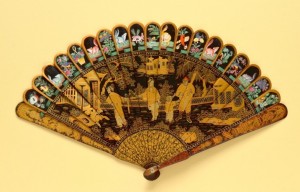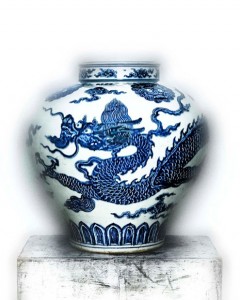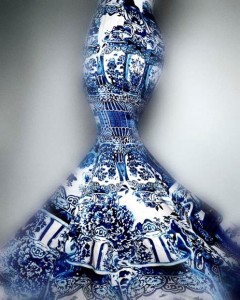Adam Geczy, in his article A Chamber of Whispers, offers a critique of orientalization in defense of the Metropolitan Museum of Art’s ‘China Though the Looking Glass’ exhibit. The Chamber of Whispers is the last section of the exhibit — juxtaposing Chinese artifacts from the 15th, 16th, and 17th centuries against the couture pieces they inspired. Gezcy wants the reader to reexamine the negative connotations of orientalization by pointing out the ways in which the East (China) was inspired by Western art. He points out cultural symbols such as the brise fan, which originated in Europe and co-opted into Chinese culture by way of printing cultural designs upon the object:
 Brise fan made in France c. 1830 – 1840
Brise fan made in France c. 1830 – 1840
He introduces the term ‘transorientalism’ as “a more serviceable term that, while admitting of ethical aspects of cultural appropriation, also supports the undeniable circumstances of exchange, re-translation, and re-envisioning embedded in the Orientalist idea, and a dynamic that still today shows no signs of abating” (Gezcy 24). Gezcy aims to protect the integrity and freedom of artists that choose to create pieces inspired by Chinese culture by defending the experimentation that cultural exchange provides. However, he fails to acknowledge the power dynamics between the East and West, and the perpetual understanding of the East as ‘other’ or ‘stuck in the past’.
wonderful claim which calls for immediate support: how could one learn about “the power dynamics” through the fan object?
 Jar with Dragon. Early 15th Century.
Jar with Dragon. Early 15th Century.  Evening Dress, fall/winter, 2005-6. This piece was inspired by the Jar with Dragon.
Evening Dress, fall/winter, 2005-6. This piece was inspired by the Jar with Dragon.
Gezcy is correct in saying that the East and West engaged in cultural exchange; the sheer volume of objects and concepts that were imported, exported, and intellectually exchanged is worthy to note. However, Western interpretations of Eastern Art seems have more cultural longevity than the original Eastern art forms. This is to say that people value the ability of Western art to legitimize aspects of Chinese culture and make it accessible to the masses. Western art, in an attempt to appreciate aspects of Chinese culture, has misinterpreted cultural symbols and as a result taken them out of context. While Chinese artists have created works influences by Western artists, there remains an understanding of where the ideas originated from and the image of Western culture is not harmed in the process.
The West has historically viewed the East as an ‘other’; a foreign, amorphous location that can be used as an artist’s playground: “Yet it is also worth remembering that, against all accusations of inauthenticity…dressing up furnished a means for expression that allowed one to do things that would have been difficult to justify in every day life” (Gezcy 27). It is this statement that unravels Gezcy’s argument, because he unabashedly describes the problematic lens through which Westerners view Chinese culture. Westerners did not have the freedom to experiment with their surroundings, and turned to Chinese culture as a means for exploration. When they had completed their exploratory phase, they created works of art that summarized their premature conclusions about Chinese culture. China has never had societal dominance in this manner. While they engaged in cultural exchange with the West, there was never a relegation of Chinese art to an inferior status.
In addition, there has not been a call from the East de-contextualize Western art from its Chinese origins in the support of academic and artistic freedom. Gezcy’s defense of the Chamber of Whispers exhibit is written under the assumption that people value Eastern and Western art equally. The consequence of using the term ‘transorientalism’ is that it purposefully ignores the inherent power imbalance involved in the exchange of Eastern and Western art.
your comments are critical and forceful. Just wish that you could use the art objects as visual evidence to support your claims
